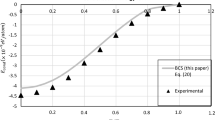Abstract
In a brief review the role of interactions in a two-component model for electronic spectrum in cuprates is discussed. Interactions in the model result in a tendency to phase separation. It is speculated that the latter determines the scale of the “pseudogap” temperature, T*, while hybridization between localized and itinerant components moderates this tendency to the first-order transition and brings about isotope mass dependence through polaronic effects.
Similar content being viewed by others
REFERENCES
K. A. Muller, in Proceedings of the IV M 2 HTSC Conference Houston, TX, Feb. 2000 (in press).
D. Rubio Temperano et al. Phys. Rev. Lett. 84, 1990 (2000).
Y. Petrov et al., Cond-Mat/0003414; R. J. McQueeney et al. Phys. Rev. Lett. 82, 628 (1999).
A. Bianconi et al. Phys. Rev. Lett. 76, 3412 (1996); H. A. Mook and F. Dogan, Nature 401, 145 (1999); N. L. Saini et al. Phys. Rev. B57, R11101 (1998).
L. P. Gor'kov and A. V. Sokol, JETP Lett. 46, 420 (1987).
R. Micnas and S. Robaszkiewicz, in High-T c Superconductivity dy1996: Ten Years After the Discovery E. Kaldis et al., eds. (NATO ASI Series, Kluwer Academic, London, 1997), p. 31; B. Brandow, Phys. Rep. 296, 1 (1998).
S. P. Ionov, Sov. Phys.-Izvestia Akad. Nauk Ser. Fiz. 49, 90 (1985).
G. M. Eliashberg, JETP Lett. Suppl. 46, S81 (1987).
D. Michailovic and K. A. Muller, in High-T c Superconductivity 1996 Ten Years After the Discovery, E. Kaldis et al. eds. (NATO ASI Series, Kluwer Academic, London, 1997) p. 31; D. Michailovic and K. A. Muller, ibid. p. 257.
J. E. Hirsch et al. Phys. Rev. B39, 243 (1989).
V. J. Emery, S. A. Kivelson, and H. Q. Lin, Phys. Rev. Lett. 64, 475 (1990).
M. Grilli et al. Phys. Rev. Lett. 67, 259 (1991).
E. Nagaev, Phys.-Uspekhi 39, 781 (1996).
J. Tranquada et al. Nature London 375, 561 (1995); Phys. Rev. B54, 7489 (1996); Phys. Rev. Lett. 78, 338 (1997).
K. A. Muller et al. J. Phys. Cond. Matt. 10, L291 (1998).
D. C. Johnston, Phys. Rev. Lett. 62, 957 (1989).
A. Alexandrov, V. Kabanov, and N. Mott, Phys. Rev. Lett. 77, 4796 (1996).
L. P. Gor'kov, J. Supercond. 12, 9 (1999).
For a short-ranged attraction the model [5] can be reduced to the Ising lattice model (L. P. Gor'kov}, unpublished)
L. M. Falicov and J. C. Kimball, Phys. Rev. Lett. 22, 997 (1969); R. Ramirez and L. M. Falicov, Phys. Rev. B3, 2425 (1971).
W. Chung and J. K. Freericks, Phys. Rev. Lett. 84, 2461 (2000).
A. Kaminski et al. Phys. Rev. Lett. 84, 1788 (2000).
Author information
Authors and Affiliations
Rights and permissions
About this article
Cite this article
Gor'kov, L.P. Phase Separation in a Two-Component Model for Cuprates. Journal of Superconductivity 13, 765–769 (2000). https://doi.org/10.1023/A:1007874418264
Issue Date:
DOI: https://doi.org/10.1023/A:1007874418264




